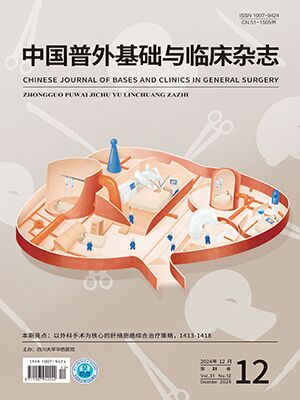| 1. |
李彦豪, 陈勇.介入治疗技术在Budd-Chiari综合征治疗中的地位[J].实用医学杂志, 2000, 16(5):350-351.
|
| 2. |
祖茂衡.Budd-Chiari综合征的影像综合诊断与介入治疗[J].中国医学计算机成像杂志, 2002, 8(2):108-115.
|
| 3. |
韩新巍, 丁鹏绪, 吴刚.布加综合征下腔静脉阻塞直径30 mm大球囊扩张的可行性研究[J].介入放射学杂志, 2008, 17(4):243-246.
|
| 4. |
张希全, 刘海军, 鹿咏红, 等.经皮经肝穿刺门静脉行胃底食管曲张静脉栓塞术治疗上消化道出血[J].中华普通外科杂志, 2005, 20(4):218-220.
|
| 5. |
肖绍树, 周学斌.部分脾栓塞治疗肝硬化门脉高压症和脾功能亢进的研究进展[J].实用肝脏病杂志, 2006, 9(3):183-184.
|
| 6. |
韩新巍, 李永东.布-加综合征介入治疗技术操作规范的几点建议[J].介入放射学杂志, 2002, 11(4):316-318.
|
| 7. |
Klein AS.Management of Budd-Chiari syndrome[J].Liver Transpl, 2006, 12(11 Suppl 2):S23-S28.
|
| 8. |
Qiao T, Liu CJ, Liu C, et al.Interventional endovascular treatment for Budd-Chiari syndrome with long-term follow-up[J].Swiss Med Wkly, 2005, 135(21-22):318-326.
|
| 9. |
成德雷, 徐浩, 华荣, 等.原发性布加综合征的病因及临床特征研究[J].中华肝脏病杂志, 2013, 21(11):850-854.
|
| 10. |
张曦彤, 徐克, 祖茂衡, 等.Budd-Chiari综合征肝静脉闭塞的介入治疗[J].中华放射学杂志, 2003, 37(5):449-453.
|
| 11. |
Patil P, Deshmukh H, Popat B, et al.Spectrum of imaging in Budd Chiari syndrome[J].J Med Imaging Radiat Oncol, 2012, 56(1):75-83.
|
| 12. |
韩新巍, 丁鹏绪, 刘冰妍, 等.Budd-Chiari综合征:国人病变肝静脉分布的影像学研究[J].临床放射学杂志, 2009, 28(2):201-204.
|
| 13. |
韩新巍, 徐克, 祖茂衡, 等.布-加综合征介入治疗与研究进展[M].郑州:郑州大学出版社, 2010:200-210.
|
| 14. |
祖茂衡.布-加综合征的影像诊断与介入治疗[M].北京:科学出版社, 2004:256-265.
|
| 15. |
祖茂衡, 徐浩, 顾玉明, 等.布-加综合征介入治疗——导丝贯穿法行下腔静脉和肝静脉成形术[J].介入放射学杂志, 2006, 15(9):521-523.
|
| 16. |
Li TX, Zhai ST, Pang ZG, et al.Feasibility and midterm outcomes of percutaneous transhepatic balloon angioplasty for symptomatic Budd-Chiari syndrome secondary to hepatic venous obstruction[J].J Vasc Surg, 2009, 50(5):1079-1084.
|
| 17. |
李金保, 权晖, 薛克, 等.经皮胃冠状静脉栓塞术后预防肝穿刺道出血的方法探讨[J].介入放射学杂志, 2014, 23(1):73-75.
|
| 18. |
李征然, 单鸿, 朱康顺, 等.肝静脉型Budd-Chiari综合征的介入治疗[J].介入放射学杂志, 2004, 13(1):25-27.
|
| 19. |
祖茂衡.布-加综合征的影像诊断与介入治疗[M].北京:科学出版社, 2004:324-327.
|
| 20. |
孙振阳, 芮清峰, 刘允乐.38例肝静脉膜型布加综合征诊治分析[J].安徽医药, 2013, 17(5):795-796.
|
| 21. |
Rautou PE, Douarin L, Denninger MH, et al.Bleeding in patients with Budd-Chiari syndrome[J].J Hepatol, 2011, 54(1):56-63.
|
| 22. |
Kawaguchi T, Sata M, Ono N, et al.Budd-Chiari syndrome complicated by hepatocellular carcinoma with no evidence of infection with hepatitis virus:a case report[J].Hepatogastroenterology, 1999, 46(30):3237-3240.
|
| 23. |
Vilgrain V, Lewin M, Vons C, et al.Hepatic nodules in Budd-Chiari syndrome:imaging features[J].Radiology, 1999, 210(2):443-450.
|
| 24. |
Liu FY, Wang MQ, Duan F, et al.Hepatocellular carcinoma associated with Budd-Chiari syndrome:imaging features and transcatheter arterial chemoembolization[J].BMC Gastroenterol, 2013, 13:105.
|
| 25. |
Aoki K, Miyamoto T, Murata H, et al.Significance of accessory hepatic venography to evaluate the intrahepatic venous system for obstruction of the inferior vena cava at the hepatic portion with main hepatic vein obstruction[J].Nihon Geka Gakkai Zasshi, 1986, 87(6):704.
|
| 26. |
Simson IW.Membranous obstruction of the inferior vena cava and hepatocellular carcinoma in South Africa[J].Gastroenterology, 1982, 82(2):171-178.
|
| 27. |
Dilawari JB, Bambery P, Chawla Y, et al.Hepatic outflow obst-ruction (Budd-Chiari syndrome).Experience with 177 patients and a review of the literature[J].Medicine (Baltimore), 1994, 73(1):21-36.
|
| 28. |
Valla DC.Primary Budd-Chiari syndrome[J].J Hepatol, 2009, 50(1):195-203.
|
| 29. |
Chen MF, Hwang TL, Jeng LB, et al.Postoperative recurrence of hepatocellular carcinoma.Two hundred five consecutive pati-ents who underwent hepatic resection in 15 years[J].Arch Surg, 1994, 129(7):738-742.
|




